Dieffenbachia is a fairly popular plant in our country, however, any experienced florist can name at least one reason why this plant should not be kept at home. The most compelling reason for refusing a flower is the toxicity of the juice secreted by this plant. A large number of cases of poisoning are known. Basically, they were recorded in children and animals who tried to chew a leaf of a poisonous flower. In adults, allergies most often occur as a result of contact of the juice with the skin.
In addition to toxicity, Dieffenbachia can also boast a host of superstitions that put it in a negative light. It should be noted that there are a couple of positive signs, but they do not relate to the content of the flower in the house. Despite all this, Dieffenbachia does not lose its popularity and continues to decorate the apartments of many lovers of decorative views.
Content
Characteristics of the Dieffenbachia plant
Dieffenbachia unites a whole genus belonging to the Aroid family. More than 60 plant species are known. Many of them are very popular in indoor floriculture. The flower has a very developed root system, its roots are prone to rapid growth, so the flower requires regular transplantation.
The main part of the species has a single stem with an apical point of growth. This feature over time causes certain difficulties. As it ages, the plant loses its lower leaves, exposing the trunk. Her decorativeness suffers from this. Florists have to cut the top with leaves and root it again. Only a few species of plants are able to cluster due to the presence of growth points on the sides of the main stem.
The stems of the plant are thickened. Oval leaves are attached to them with petioles. They represent the decorative value of the flower. The leaves of Dieffenbachia have an unusual color, represented by a combination of green and white (yellow) color. Only a couple of certain species are distinguished by solid green leaves.
Dieffenbachia is capable of blooming. The inflorescence consists of a creamy cob framed by a yellow-green bedspread. At home, it is very difficult to achieve flowering. You can appreciate the charm of the color of Dieffenbachia in the photo.
The following types of plants are considered the most common:
- Motley (Colorized). Large fast-growing species. On a dark green background of the leaves there is a thick yellow-green speck. Petiole and central vein are light green.
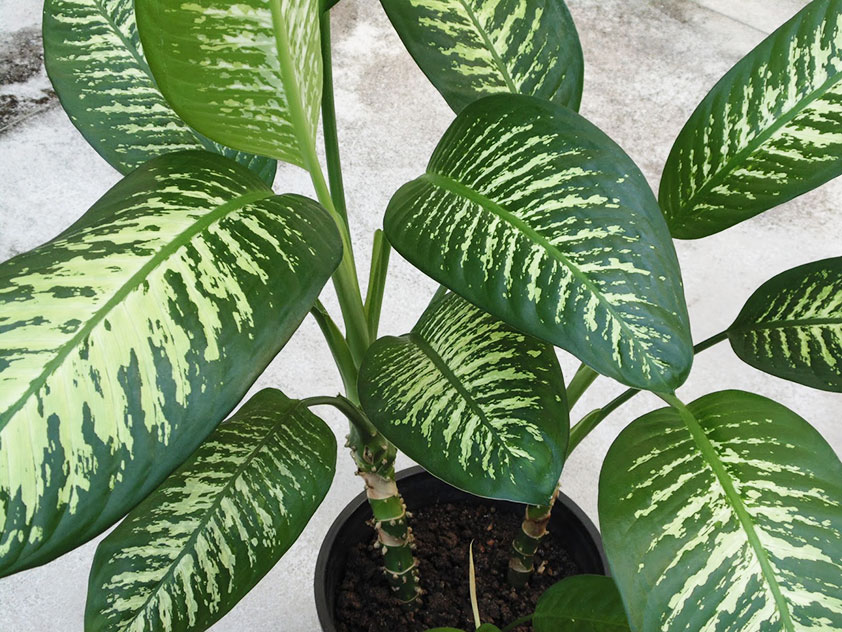
Dieffenbachia motley - Spotted. Short stature with axillary leaves. The leaf plate is white-yellow with an uneven green border.
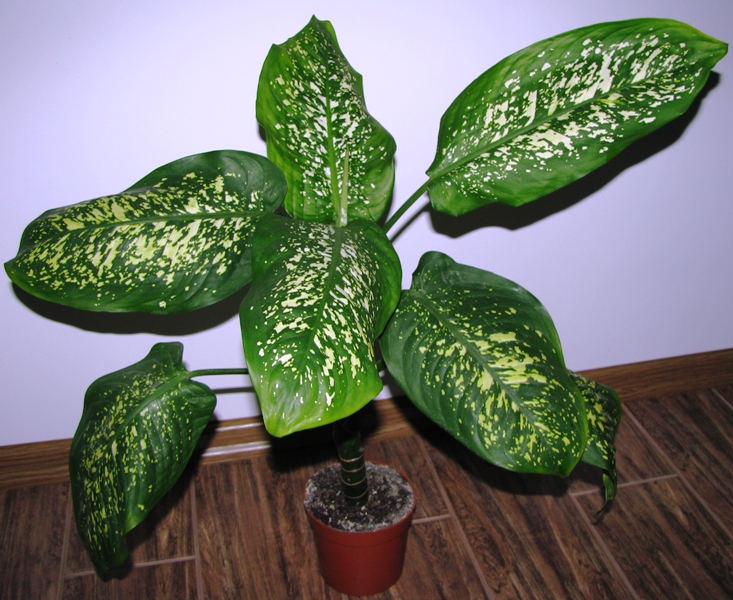
Dieffenbachia spotted - Leopold. Undersized appearance. The surface of the sheet has a plain green color with a pronounced longitudinal vein of white color.
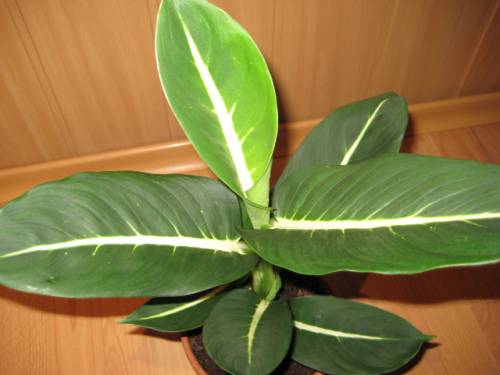
Leopold - Lovely (Pleasant). Dieffenbachia is medium in size. Differs in unpretentiousness in leaving. The leaves are dark green. Transverse veins are distinguished by uneven white strokes.
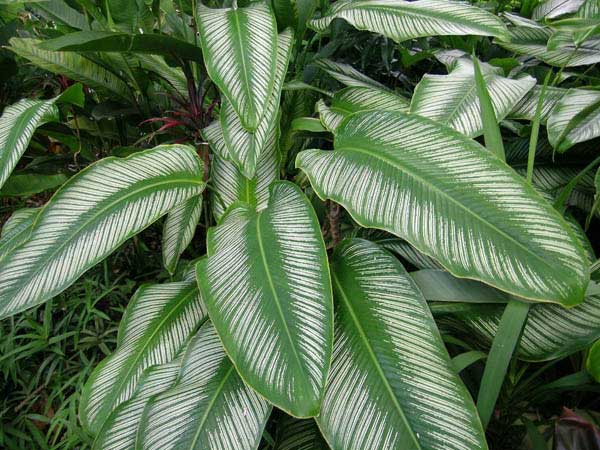
Lovely - Seguin. Very similar to the representatives of the charming look. It features wider leaves. White strokes surround the transverse veins, leaving them dark green.
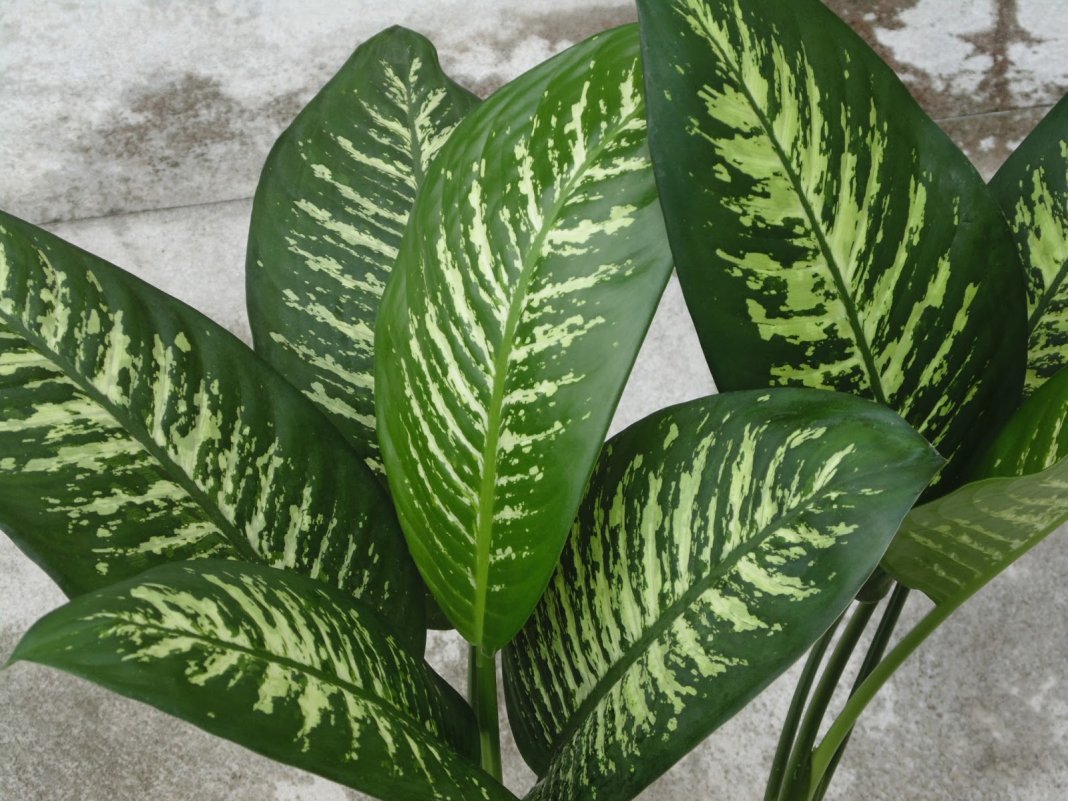
Seguin - Oersted. It differs in monophonic bright green leaves with a distinct central vein.
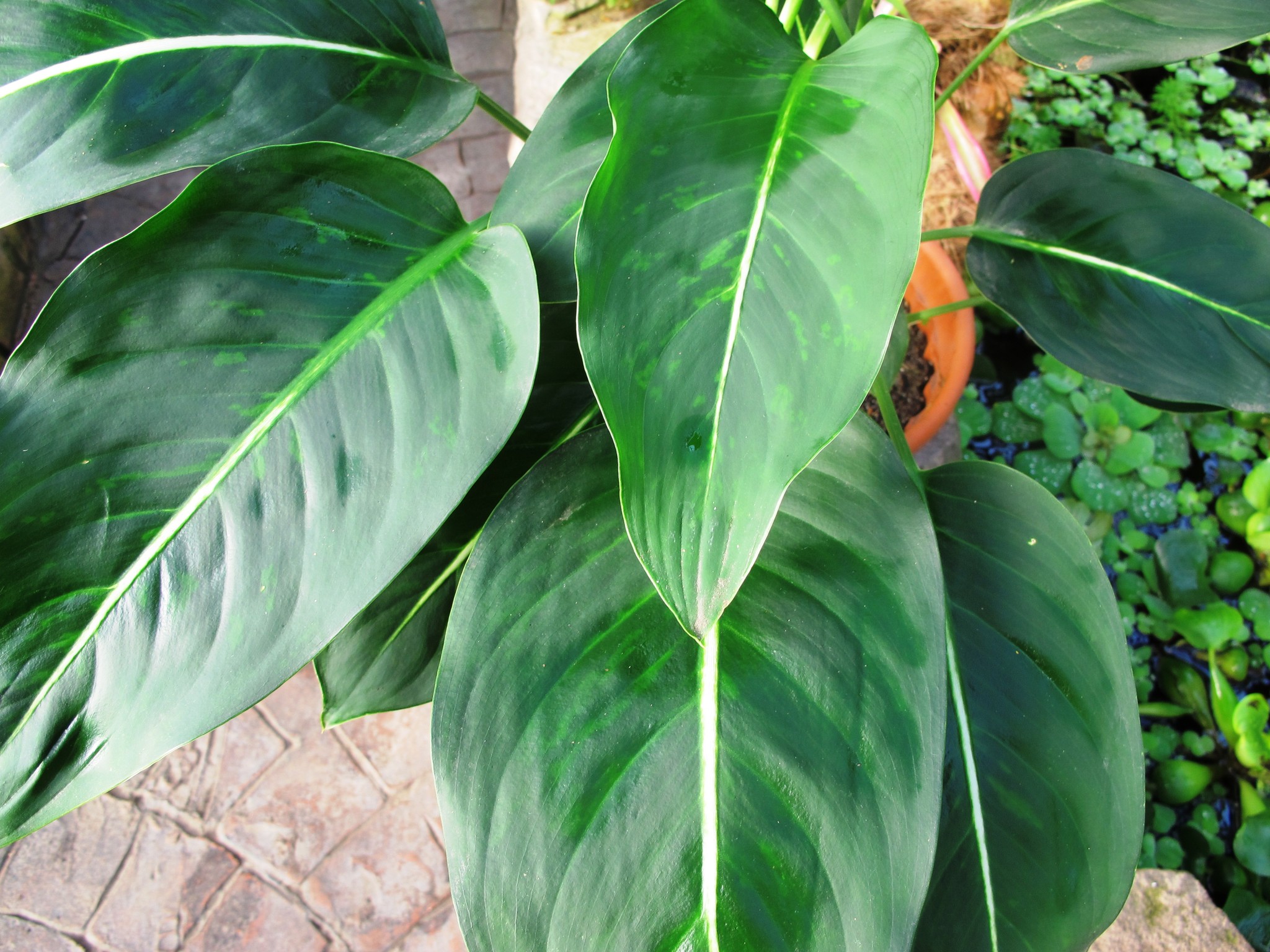
Oersted - Gorgeous. It is characterized by light green large leaves with white-yellow stains along the transverse veins.The central core is painted in the tone of a sheet plate.
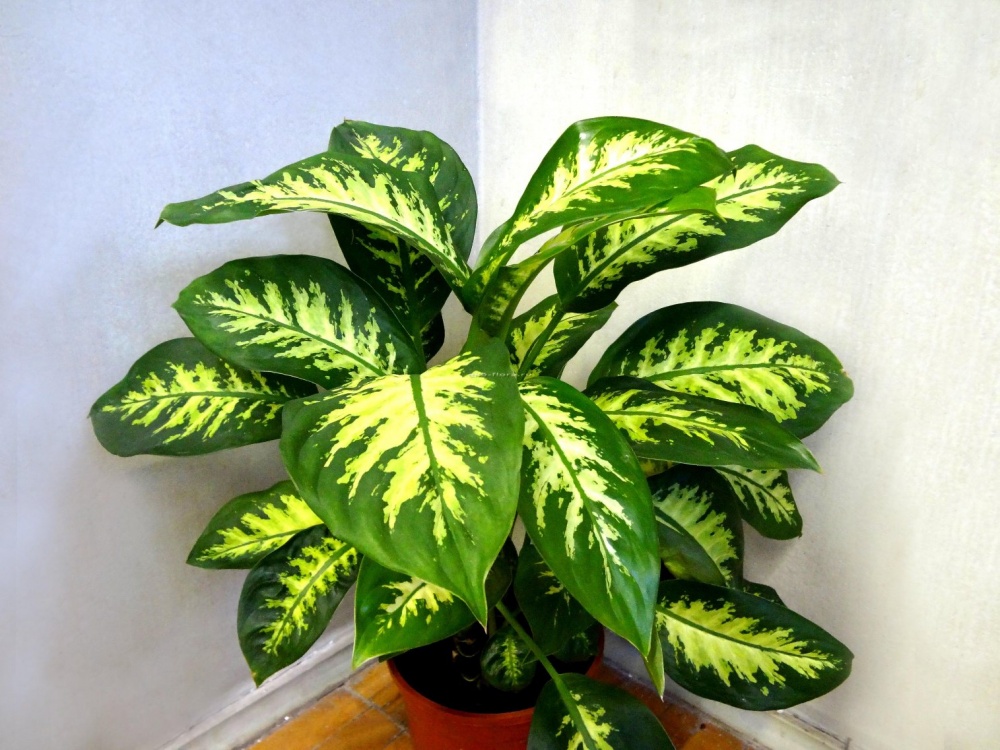
Gorgeous - Large-leaved. Low appearance with very long leaves that have a plain green color. The longitudinal vein is noticeably thickened.
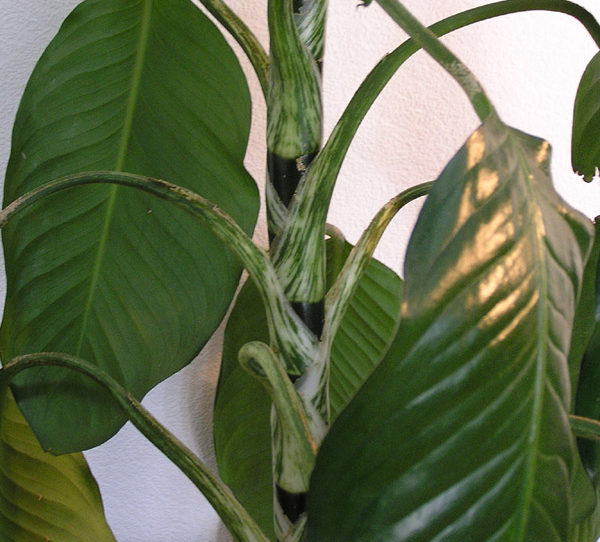
Large leaf - Bauman. It differs by the largest leaves, capable of reaching up to 70 cm. Plates of bright green color with white specks along the transverse veins.
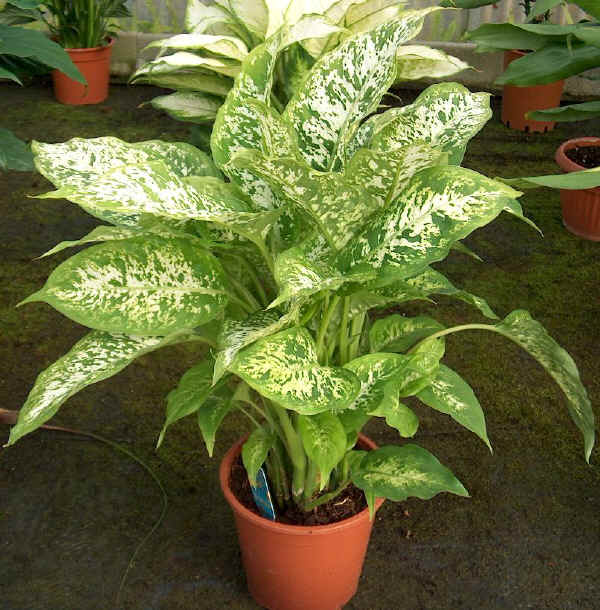
Bauman - Bause. It is characterized by a marble color of leaves. In the middle, yellow-green shades predominate, along the edge - dark green. The central vein is dark green.
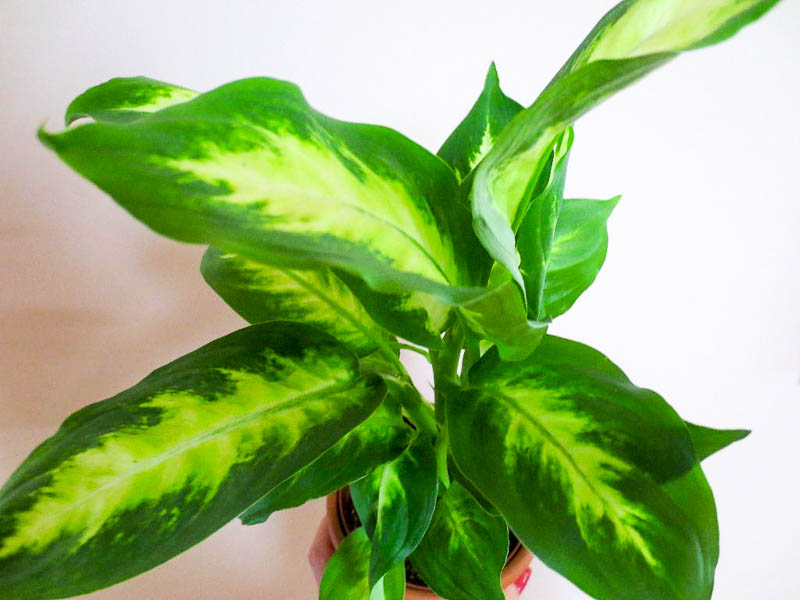
Bauze - Green Magic. Representatives of this species are very similar to Dieffenbachia Leopold. They differ in a darker color.
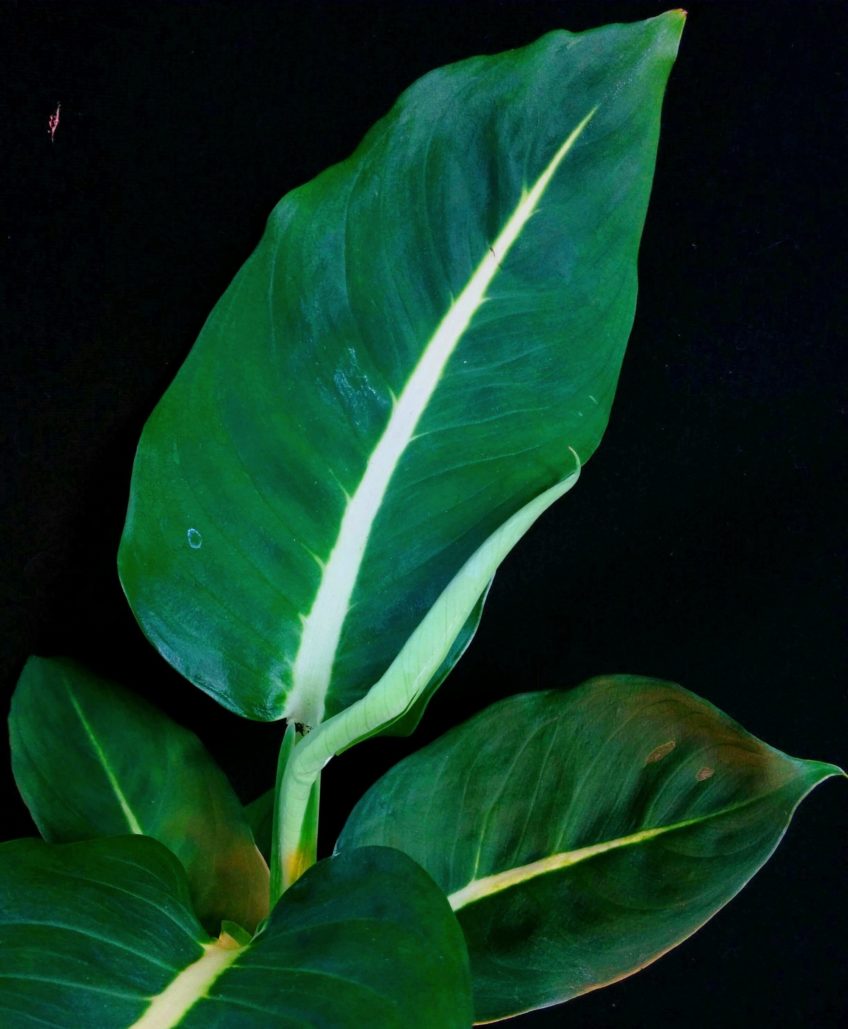
Green Magic - Compact. Undersized appearance. It grows about half a meter. Leaves are also compact. The color is represented by a thick white speck of different bunkers on a bright green background.
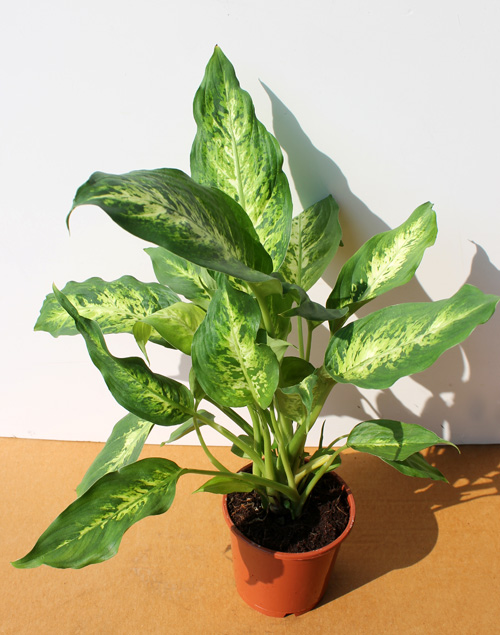
Compact - Camilla Reminds Dieffenbachia Spotted. It differs from it in more compact dimensions and a lighter edging.
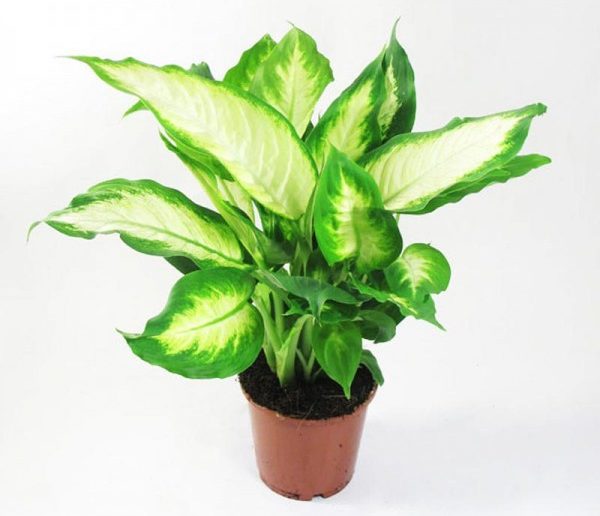
Camilla
Dieffenbachia is striking in its size. The height of the trunk can reach several meters, and the diameter of the sheet - up to half a meter.
Why you can not keep Dieffenbachia at home according to signs and superstitions
A large number of negative signs and superstitions are associated with growing a flower in a house:
- Deterioration of financial condition. There is a belief that the plant repels material well-being. In the house where the flower grows, there is an acute shortage of money, up to the development of poverty.
- House without guests. The flower scares visitors away with its heavy energy. In a room with a plant, guests feel uncomfortable, try to leave the house faster and do not feel like returning there.
- Misunderstanding between generations. Dieffenbachia is believed to be disruptive in relations between children and parents.
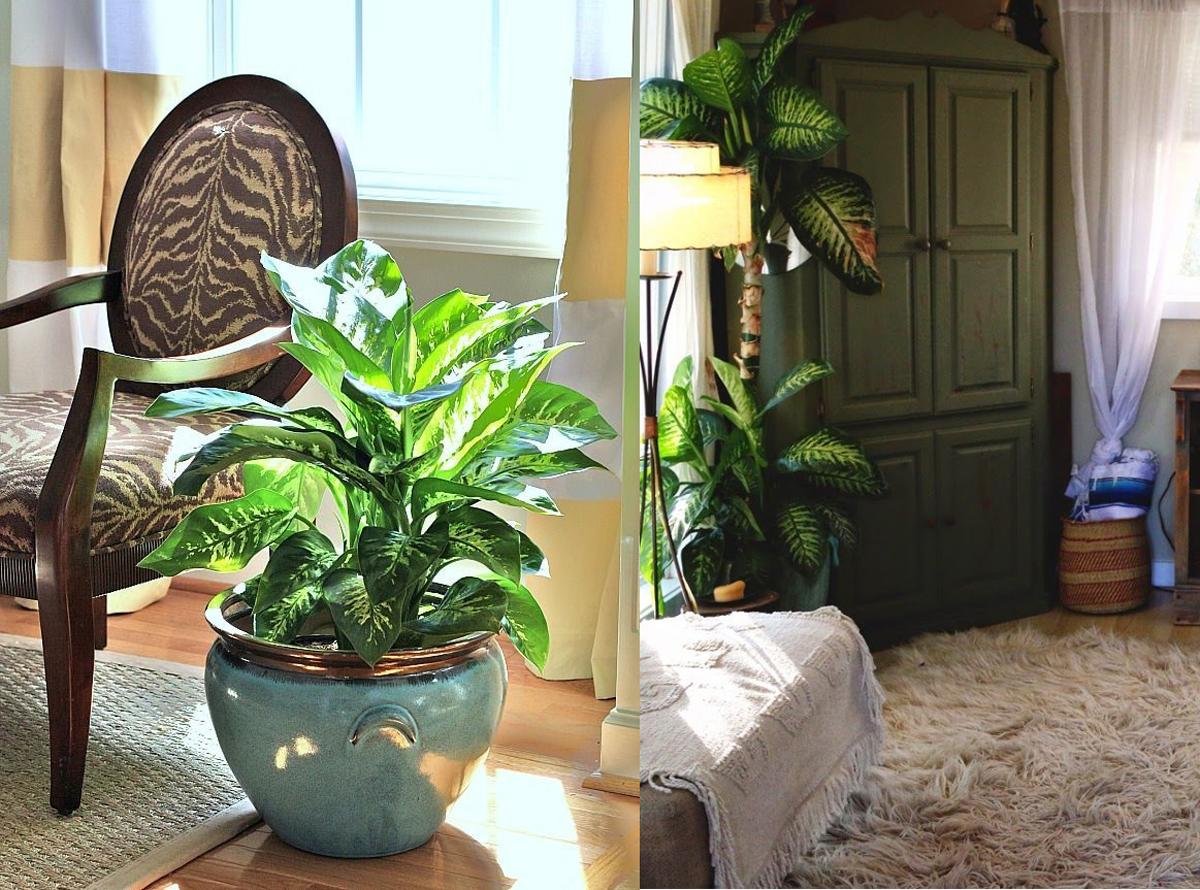
Dieffenbachia in the room - Infertility. There is a sign that the flower in every way prevents the appearance of a baby in the house.
- Impotence. The plant inhibits male power, contributes to the loss of interest in women.
- Adultery. Placing a flower in the bedroom contributes to the loss of interest in each other.
- "Husbandry flower." It is believed that the plant should not be grown by unmarried girls. The flower is jealous of the hostess and does not admit men to her.
- Scandal generator. Dieffenbachia in the house provokes family quarrels and scandals.
- Pest. There is a belief that the plant has a bad effect on the human nervous system. Owners of a flower disturb sleep and develop neurosis.
- The loss of a pet. Popular superstitions say that animals do not take root in a house where Dieffenbachia grows. They either leave or die.
It will take about the positive effect of the plant by an order of magnitude less, but still they are:
- Hazard warning. The plant blooms extremely rarely. But if it bloomed, you should be extremely careful and careful. Flowering plant reports impending major troubles. Perhaps they will not be able to turn away, but "warned - armed."
- New business. The plant in every way contributes to the development of a new business.
- Great career. The flower loves business people, therefore it helps them to climb the career ladder. But the plant should be placed directly at the workplace.
- Office assistant. Placing a flower in the office contributes to success in work.
- Tutoring plant. Flowers in educational institutions help students to master larger volumes of information, develop intelligence and mental abilities.
The danger of dieffenbachia to human health
There is no pronounced odor in dieffenbachia. The juice contains toxic substances, presumably needle-sharp crystals of calcium oxalate. Upon contact with the body, the juice causes intoxication.
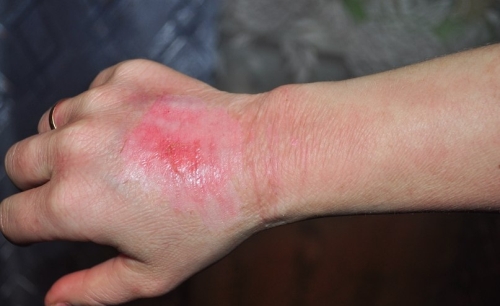
When juice enters the skin, an allergic reaction occurs. For each person, it can be expressed in different ways. At the site of the reaction, redness, hives, burns, blisters, ulcers may occur. In people with individual intolerance to the substances contained in the juice, an allergic reaction of varying degrees of complexity occurs.
Cases of the development of heart failure due to an allergic reaction to the toxin are known. If juice enters the eyes, a burn of the cornea is possible. This is fraught with temporary or permanent loss of vision.
Juice that enters the stomach causes poisoning. A person feels general malaise, dizziness, nausea and headache. Vomiting and / or diarrhea may begin. Contact with the mucous membrane of the oral cavity causes swelling of the larynx and temporary loss of speech. A person who swallows a piece of Dieffenbachia experiences pain in his mouth and esophagus.
To prevent juice poisoning during plant care, personal protective equipment should be used. Experts recommend the use of rubber gloves during transplantation, pruning and peeling of Dieffenbachia leaves.
The situation is more complicated with young children and pets. Learning the world, kids try everything on the tooth. It is impossible for them to explain the causes and consequences of violation of the prohibition to touch the flower.
Animals can also suffer from dieffenbachia. This is especially true for excessively curious cats. Having chewed a leaf of a plant, a pet may even die. In a house where small children and pets live, it is recommended not to grow Dieffenbachia. If the flower has become so dear that it is impossible to refuse it, it should be moved to a place inaccessible to the small and tailed inhabitants of the house.
Positive properties of Dieffenbachia
Despite the many negative qualities of Dieffenbachia, it can also be beneficial. A flower, like tradescantia, is a natural humidifier. The broad leaves of the plant constantly evaporate moisture. It’s easier to breathe next to Dieffenbachia, thoughts become clearer.
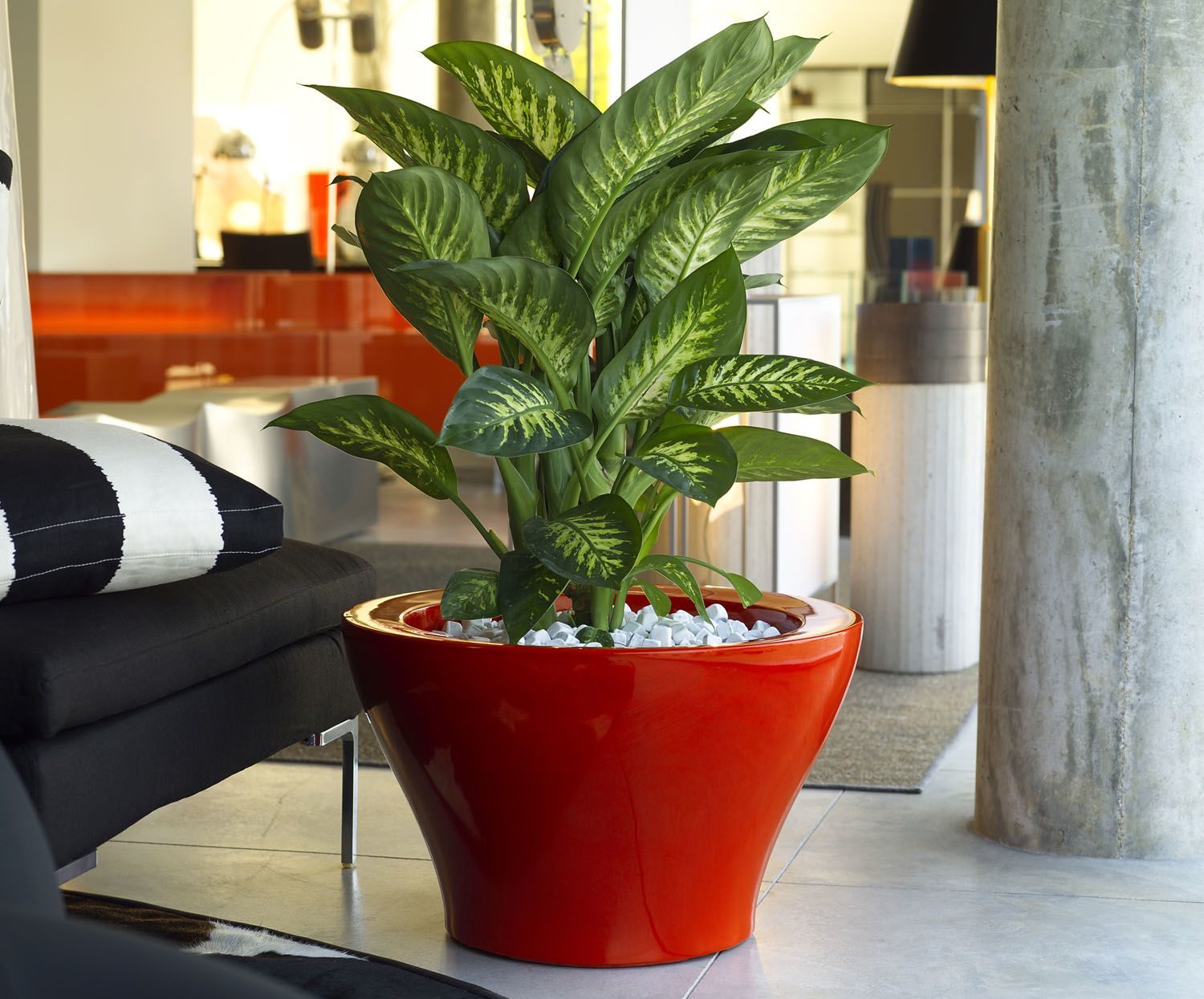
The flower is great for people who are allergic to dust. Unlike many other ornamental plants, Dieffenbachia leaves have a smooth surface. It is convenient to collect dust from them during regular cleaning.
Thanks to phytoncides contained in Dieffenbachia, the plant is able to purify the air. The immune system of the flower is protected from pathogenic bacteria and microorganisms, destroying them. At the same time, the plant protects people nearby. Therefore, Dieffenbachia can often be found in hospitals and other medical institutions, as well as in crowded places.
In forums devoted to the discussion of Dieffenbachia, plant owners talk about the positive effects of the flower. Next to him, women feel comfortable and cozy. Some gardeners claim that Dieffenbachia helped them lose weight.
Even in signs of a flower that carry a negative value, one can find positive points. So the plant does not pose an energy hazard for older couples and women who are not seeking to get married. Signs about Dieffenbachia’s ability to promote business and increase working efficiency make the flower indispensable for men who spend a lot of time at work.
Common plant questions
Dieffenbachia is highly decorative. But it contains toxic substances that are dangerous to humans and pets. The people there are many signs about the flower, the bulk of which is not advised to grow dieffenbachia.

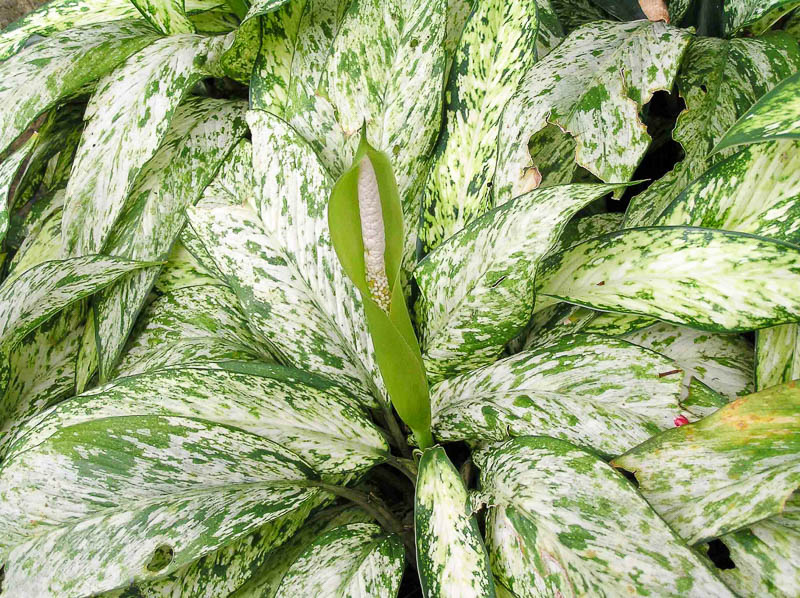
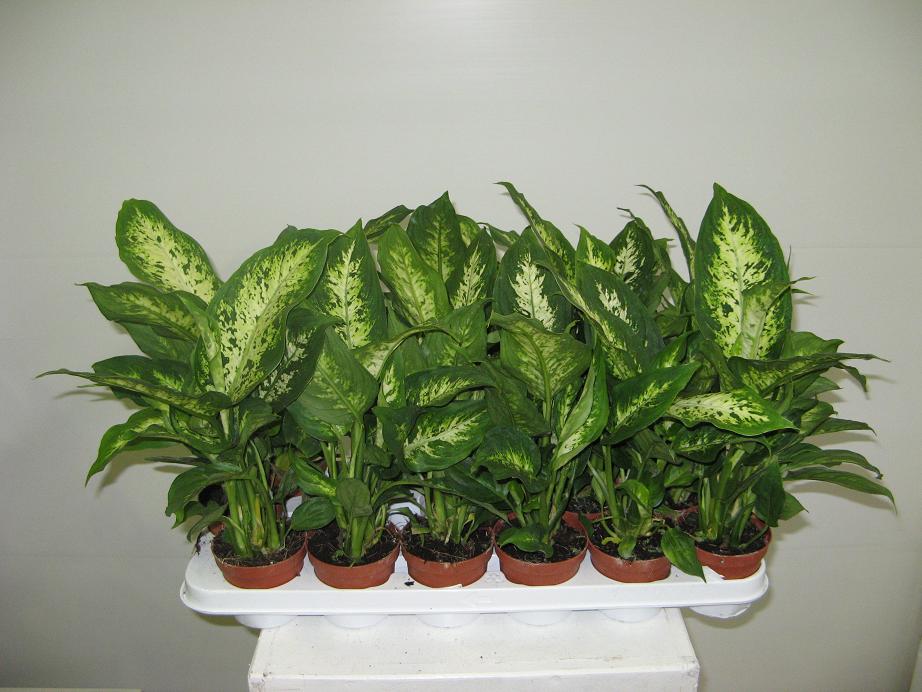
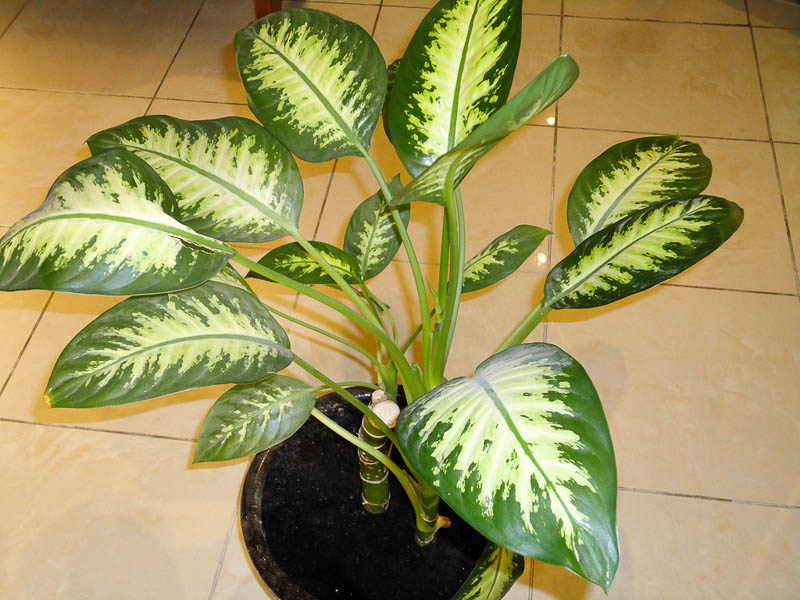



 10 beautiful annuals that bloom all summer
10 beautiful annuals that bloom all summer Sow in the ground, without seedlings: 10 beautiful and unpretentious flowers
Sow in the ground, without seedlings: 10 beautiful and unpretentious flowers Platicodon planting and outdoor care
Platicodon planting and outdoor care Hosta - planting and care in the open ground in the Urals
Hosta - planting and care in the open ground in the Urals